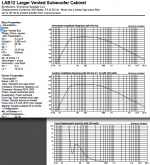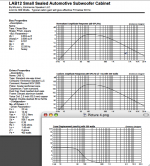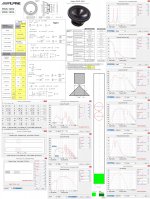I am a total newbie planning on building a pair subs for fun and as learning experience so I need lots and lots of help. Please also feel free to critique my ideas.
Space:
This is for a house that I am building, it's in design stage. It will have an open floor plan, the listening area (kitchen/family) would be: 26' x 27' x 9' = 6318 ft3. but there's no back wall, it just open into an bigger area (living/dining): 30' x 30' x 22' = 19,800 ft3.
Front wall:
19ft wide and 9ft ceiling.
What I want to do:
-A pair of corner subs for the two corners of front wall.
-Both subs floor to ceiling.
-triangular shaped designed to accommodate up to 10" driver(s) firing into the room.
-toying with the idea of push-pull, with the drivers at each end, ie one at close to the ceiling, and the other close to the floor.
-It will look like an in-wall, in fact, could actually frame it as such but probably won't do it that way in case it sound really bad 😉
OK, newbie questions:
-where do I find software to design subs?
-how to determine box volume in relationship to driver(s)?
-advantage or disadvantage of having smaller driver in bigger enclosures?
Space:
This is for a house that I am building, it's in design stage. It will have an open floor plan, the listening area (kitchen/family) would be: 26' x 27' x 9' = 6318 ft3. but there's no back wall, it just open into an bigger area (living/dining): 30' x 30' x 22' = 19,800 ft3.
Front wall:
19ft wide and 9ft ceiling.
What I want to do:
-A pair of corner subs for the two corners of front wall.
-Both subs floor to ceiling.
-triangular shaped designed to accommodate up to 10" driver(s) firing into the room.
-toying with the idea of push-pull, with the drivers at each end, ie one at close to the ceiling, and the other close to the floor.
-It will look like an in-wall, in fact, could actually frame it as such but probably won't do it that way in case it sound really bad 😉
OK, newbie questions:
-where do I find software to design subs?
-how to determine box volume in relationship to driver(s)?
-advantage or disadvantage of having smaller driver in bigger enclosures?
1-where do I find software to design subs?
2-how to determine box volume in relationship to driver(s)?
3-advantage or disadvantage of having smaller driver in bigger enclosures?
1) Hornresp is an excellent free software program which can help you compare most sub enclosure types. No software is actually capable of designing subs, software can suggest alignments for various driver choices, which makes it possible to compare simulations without having to purchase the drivers and build the enclosure.
Hornresp
2) Box volume is tied to a variety of driver parameters, but in general bigger boxes require less power to achieve the same SPL (sound pressure level).
3) Smaller drivers with the same excursion as larger drivers have less displacement, the more displacement the more SPL capability.
Thanks Weltersys for your help. Any advantage on small driver vs big sonically? How about multiple of 6" vs a single 15" or 18"?
Smaller drivers can have a higher upper frequency response limit than larger drivers, but in the "sub" context, reaching to the usual crossover region of 100 Hz or less is no problem for most 18", so there is generally no sonic advantage to multiple small drivers compared to a larger driver with the same Sd. That said, multiple voice coils may dissipate heat better than a single voice coil, resulting in less "thermal compression".Thanks Weltersys for your help. Any advantage on small driver vs big sonically? How about multiple of 6" vs a single 15" or 18"?
A long excursion driver of only 6" diameter looses relatively much more surface area to the surround (a small driver still needs the same diameter surround, as a larger driver, but only half the surround contributes to Sd) than a larger driver, reducing the displacement available from a given baffle area. In general, 12" to 18" gives the best "bang for the buck" from a displacement standpoint.
Will this work?
1. Triangular corner sealed enclosure, 9" on the two sides, 8.5ft tall with 1inch thick walls. Internal volume: 0.944 ft3
2. Use Eminence Lab 12C High Power 12" Subwoofer Speaker Driver 4 Ohm
Nominal Diameter: 12"Power
Handling (RMS): 500 Watts
Power Handling (max): 1000 Watts
Impedance: 4 ohms
Frequency Response: 25 to 120 Hz
Sensitivity: 88.9 dB 1W/1m
Voice Coil Diameter: 2.5"Magnet
Weight : 160 oz.
THIELE-SMALL PARAMETERS
Resonant Frequency (Fs): 22.85 Hz
DC Resistance (Re): 3.11 ohms
Voice Coil Inductance (Le): 1.09 mH
Mechanical Q (Qms): 11.7
Electromagnetic Q (Qes): 0.34
Total Q (Qts): 0.33
Compliance Equivalent Volume (Vas): 4.53 ft.³
Maximum Linear Excursion (Xmax): 13 mm
MATERIALS OF CONSTRUCTION
Cone Material: Paper / Kevlar
Surround Material: Foam
Basket / Frame Material: Cast Aluminum
Magnet Material: Ferrite
MOUNTING INFORMATION
Overall Outside Diameter: 12.32"
Baffle Cutout Diameter: 10.98"
Depth: 6.44"
OPTIMUM CABINET SIZE (DETERMINED USING BASSBOX 6 PRO HIGH FIDELITY SUGGESTION)
Sealed Volume: 0.9 ft.³
Sealed F: 355 Hz
Vented Volume: 1.89 ft.³
Vented F: 333 Hz
1. Triangular corner sealed enclosure, 9" on the two sides, 8.5ft tall with 1inch thick walls. Internal volume: 0.944 ft3
2. Use Eminence Lab 12C High Power 12" Subwoofer Speaker Driver 4 Ohm
Nominal Diameter: 12"Power
Handling (RMS): 500 Watts
Power Handling (max): 1000 Watts
Impedance: 4 ohms
Frequency Response: 25 to 120 Hz
Sensitivity: 88.9 dB 1W/1m
Voice Coil Diameter: 2.5"Magnet
Weight : 160 oz.
THIELE-SMALL PARAMETERS
Resonant Frequency (Fs): 22.85 Hz
DC Resistance (Re): 3.11 ohms
Voice Coil Inductance (Le): 1.09 mH
Mechanical Q (Qms): 11.7
Electromagnetic Q (Qes): 0.34
Total Q (Qts): 0.33
Compliance Equivalent Volume (Vas): 4.53 ft.³
Maximum Linear Excursion (Xmax): 13 mm
MATERIALS OF CONSTRUCTION
Cone Material: Paper / Kevlar
Surround Material: Foam
Basket / Frame Material: Cast Aluminum
Magnet Material: Ferrite
MOUNTING INFORMATION
Overall Outside Diameter: 12.32"
Baffle Cutout Diameter: 10.98"
Depth: 6.44"
OPTIMUM CABINET SIZE (DETERMINED USING BASSBOX 6 PRO HIGH FIDELITY SUGGESTION)
Sealed Volume: 0.9 ft.³
Sealed F: 355 Hz
Vented Volume: 1.89 ft.³
Vented F: 333 Hz
I would recommend you go the DSP route, then you can just build whatever box is convenient and fix the response to what you want afterwards.
There are even nice DSP plate amps nowadays.
There are even nice DSP plate amps nowadays.
Depends on what you mean by "work", a cabinet that small will roll off the low end severely, and would require full power to deliver a rather anemic output. The Lab 12 (or Lab12 C if you want a lower impedance voice coil) works well with around 2-3 cubic foot volume tuned anywhere from 19-36 Hz. With the small .9 sealed cabinet, output would be only around 104 dB at 30 Hz with 400 watts, with a 3.2 cubic foot (net) cabinet tuned to 25 Hz, output would be 114 dB at 30 Hz with the same 400 watts. A 10 dB difference is huge, sounds twice as loud at 1000 Hz, while it only takes a 5 dB difference to sound twice as loud at 20 Hz- the larger ported cabinet would have the capability of sounding almost four times as loud down low where our hearing is least sensitive.Will this work?
Hi toffee123,
The LAB12 is a very versatile driver. It's been used from dual driver front loaded horns all the way to small single driver sealed boxes, and anything in between.
If you are looking at a tall box w/ a small (but not too small) footprint take a look here:
http://www.diyaudio.com/forums/subwoofers/143714-lab12-tapped-horn.html
particularly Posts # 181/188 and 251 for tall tapped horns w/ a small footprint.
Then there are a number of mass-loaded transmission lines in this thread:
http://www.diyaudio.com/forums/subw...ded-transmission-line-od-ml-tl-design-bj.html
For sealed boxes you might look at an internal net volume range from 40L to 70L. For a vented box try V_net=90L w/ 2ea. 3"Dia. x 20" long duct ports. These are net internal volumes, no driver, no braces, no ducts...
Finally, take a look at gedlee's multi sub approach here, practical information in the link in w/ Post #5 (this may involve some tracking down of the information):
http://www.diyaudio.com/forums/subwoofers/134568-multiple-small-subs-geddes-approach.html
Whatever you do, take Art's (weltersys) advice from Post #2, and download Hornresp .
Regards,
The LAB12 is a very versatile driver. It's been used from dual driver front loaded horns all the way to small single driver sealed boxes, and anything in between.
If you are looking at a tall box w/ a small (but not too small) footprint take a look here:
http://www.diyaudio.com/forums/subwoofers/143714-lab12-tapped-horn.html
particularly Posts # 181/188 and 251 for tall tapped horns w/ a small footprint.
Then there are a number of mass-loaded transmission lines in this thread:
http://www.diyaudio.com/forums/subw...ded-transmission-line-od-ml-tl-design-bj.html
For sealed boxes you might look at an internal net volume range from 40L to 70L. For a vented box try V_net=90L w/ 2ea. 3"Dia. x 20" long duct ports. These are net internal volumes, no driver, no braces, no ducts...
Finally, take a look at gedlee's multi sub approach here, practical information in the link in w/ Post #5 (this may involve some tracking down of the information):
http://www.diyaudio.com/forums/subwoofers/134568-multiple-small-subs-geddes-approach.html
Whatever you do, take Art's (weltersys) advice from Post #2, and download Hornresp .
Regards,
http://www.diyaudio.com/forums/subwoofers/134568-multiple-small-subs-geddes-approach.html
Markus's link doesn't work and couldn't find anything on his homepage..........
Regardless, this business of subs being separated vertically by ~9 ft has performance consequences and imposes system design limitations that need addressing before going any further.
GM
Markus's link doesn't work and couldn't find anything on his homepage..........
Regardless, this business of subs being separated vertically by ~9 ft has performance consequences and imposes system design limitations that need addressing before going any further.
GM
Hi,
Here is another link on multiple subs:
http://www.diyaudio.com/forums/subw...ultisub-setup-temporary-rental-apartment.html
Regards,
Here is another link on multiple subs:
http://www.diyaudio.com/forums/subw...ultisub-setup-temporary-rental-apartment.html
Regards,
Depends on what you mean by "work", a cabinet that small will roll off the low end severely, and would require full power to deliver a rather anemic output. The Lab 12 (or Lab12 C if you want a lower impedance voice coil) works well with around 2-3 cubic foot volume tuned anywhere from 19-36 Hz. With the small .9 sealed cabinet, output would be only around 104 dB at 30 Hz with 400 watts, with a 3.2 cubic foot (net) cabinet tuned to 25 Hz, output would be 114 dB at 30 Hz with the same 400 watts. A 10 dB difference is huge, sounds twice as loud at 1000 Hz, while it only takes a 5 dB difference to sound twice as loud at 20 Hz- the larger ported cabinet would have the capability of sounding almost four times as loud down low where our hearing is least sensitive.
I actually reduced the size of the enclosure to match what was on parts-express's recommendation. In this case, it said:
OPTIMUM CABINET SIZE (DETERMINED USING BASSBOX 6 PRO HIGH FIDELITY SUGGESTION)
Sealed Volume: 0.9 ft.³
Sealed F: 355 Hz
Should I ignore? How does one determine the box volume? The box that I was thinking would be 2ft3, with internal measurement of (1ft x 1ft x 8.75ft)/2 = 2.18ft3 then minus the bracing, driver etc.,
Hi,
I can tell your not into acoustics with those sort of room dimensions,
26' x 27' x 9' = 6318 ft3 opening into 30' x 30' x 22' = 19,800 ft3,
near 3:3:1 into near 3:3:2 but a least they are spaced apart a little.
I can tell you the problems of such sort of spaces are unknown to most of
us who use a decently ratio'd box as a (relatively small) listening room.
YMMV but I'm not aware of a nice system that needs speakers 26' apart
and IMO you'd do a lot better with speakers with built in subs effectively,
or the subs located on the back wall, somewhat offset behind the speakers.
rgds, sreten.
I can tell your not into acoustics with those sort of room dimensions,
26' x 27' x 9' = 6318 ft3 opening into 30' x 30' x 22' = 19,800 ft3,
near 3:3:1 into near 3:3:2 but a least they are spaced apart a little.
I can tell you the problems of such sort of spaces are unknown to most of
us who use a decently ratio'd box as a (relatively small) listening room.
YMMV but I'm not aware of a nice system that needs speakers 26' apart
and IMO you'd do a lot better with speakers with built in subs effectively,
or the subs located on the back wall, somewhat offset behind the speakers.
rgds, sreten.
correction
An 18-inch bass driver - I personally wouldn't even go there. The cone is so big you got two issues to contend with: One is unwanted "waves" developing ACROSS the cone material, and the other is flabby muddy response. They are just too big.
Two drivers with effective response from 40 Hz to (whatever) in the same enclosure would have an effective response from 20 Hz to (whatever). They don't even have to be in the same enclosure, simply aligned in the same plane. I personally prefer the multiple smaller driver approach. It just works much better and is probably more cost-effective.
There are benefits to using multiple smaller drivers instead of a large driver. 2 or 4 small drivers react faster and give cleaner, tighter base than a single large driver. Their voice coils will probably dissipate heat better, not a small consideration in the bass region.Smaller drivers can have a higher upper frequency response limit than larger drivers, but in the "sub" context, reaching to the usual crossover region of 100 Hz or less is no problem for most 18", so there is generally no sonic advantage to multiple small drivers compared to a larger driver with the same Sd. That said, multiple voice coils may dissipate heat better than a single voice coil, resulting in less "thermal compression".
A long excursion driver of only 6" diameter looses relatively much more surface area to the surround (a small driver still needs the same diameter surround, as a larger driver, but only half the surround contributes to Sd) than a larger driver, reducing the displacement available from a given baffle area. In general, 12" to 18" gives the best "bang for the buck" from a displacement standpoint.
An 18-inch bass driver - I personally wouldn't even go there. The cone is so big you got two issues to contend with: One is unwanted "waves" developing ACROSS the cone material, and the other is flabby muddy response. They are just too big.
Two drivers with effective response from 40 Hz to (whatever) in the same enclosure would have an effective response from 20 Hz to (whatever). They don't even have to be in the same enclosure, simply aligned in the same plane. I personally prefer the multiple smaller driver approach. It just works much better and is probably more cost-effective.
That box size may be appropriate for the trunk of a car (the Lab12"C"was made to take advantage 12 volt amplifiers designed to operate at very low impedance), where cabin gain will make up for the rolled off low frequency, but is not appropriate for a relatively large room which won't provide low frequency gain.I actually reduced the size of the enclosure to match what was on parts-express's recommendation. In this case, it said:
OPTIMUM CABINET SIZE (DETERMINED USING BASSBOX 6 PRO HIGH FIDELITY SUGGESTION)
Sealed Volume: 0.9 ft.³
Sealed F: 355 Hz
Should I ignore? How does one determine the box volume? The box that I was thinking would be 2ft3, with internal measurement of (1ft x 1ft x 8.75ft)/2 = 2.18ft3 then minus the bracing, driver etc.,
One determines box volume by multiplying height x width x depth, then subtracting the bracing, driver etc. Your example seems to be only half of what it should be.
Driver TS parameters, box volume and design all determine frequency and phase response. As TB 46 says, the Lab 12 is a very versatile driver- I have used them in dozens of different enclosures, each fitting different design goals.
Here are two examples of quite different responses in simple cabinets, using tapped horn designs can increase output another 6 dB compared to the larger ported design, but will occupy slightly more volume.
Attachments
Size and volume of my enclose, being tall and triangular in shape, I think this is how the volume will be:
1.
2 sides - 12" (internal)
tall - 103"
internal volume: appr. 4ft3 after braces etc
2.
2 sides - 11" (internal)
tall - 103"
internal volume: appr. 3.34 ft3 after braces etc
3.
2 sides - 10" (internal)
tall - 103"
internal volume: appr. 2.7 ft3 after braces etc
I don't know sure which driver to use, don't have any experience at all.
1.
2 sides - 12" (internal)
tall - 103"
internal volume: appr. 4ft3 after braces etc
2.
2 sides - 11" (internal)
tall - 103"
internal volume: appr. 3.34 ft3 after braces etc
3.
2 sides - 10" (internal)
tall - 103"
internal volume: appr. 2.7 ft3 after braces etc
I don't know sure which driver to use, don't have any experience at all.
Without defining some goals (how loud, how low, how efficient) there is no way to determine appropriate driver (s), but the Lab 12 is a time proven good performer in terms of the usual parameters- good LF extension (low FS), plenty of magnet power (high BL), low distortion, good build quality, good value for displacement.I don't know sure which driver to use, don't have any experience at all.
Depends on what you mean by "work", a cabinet that small will roll off the low end severely, and would require full power to deliver a rather anemic output. The Lab 12 (or Lab12 C if you want a lower impedance voice coil) works well with around 2-3 cubic foot volume tuned anywhere from 19-36 Hz. With the small .9 sealed cabinet, output would be only around 104 dB at 30 Hz with 400 watts, with a 3.2 cubic foot (net) cabinet tuned to 25 Hz, output would be 114 dB at 30 Hz with the same 400 watts. A 10 dB difference is huge, sounds twice as loud at 1000 Hz, while it only takes a 5 dB difference to sound twice as loud at 20 Hz- the larger ported cabinet would have the capability of sounding almost four times as loud down low where our hearing is least sensitive.
Without defining some goals (how loud, how low, how efficient) there is no way to determine appropriate driver (s), but the Lab 12 is a time proven good performer in terms of the usual parameters- good LF extension (low FS), plenty of magnet power (high BL), low distortion, good build quality, good value for displacement.
Let me try to define:
1. How loud:
We seldom go very loud, for most music and movies, we probably go around 70-85db, occasionally (few times a year) tops out at 100db. However, the space is somewhat bigger (see original post) than normal domestic music room and my aging ears probably aren't working at 100% efficiency.
2. How low:
Not a pipe organ freak nor enjoy watching movie with super low stuff. I would like 25-30Hz? For most music, I found that I appreciate a small boost at the 45-90hz.
3. How efficient:
I wouldn't mind buying powerful amps.
If I would to use a sealed 4ft3 enclosure (triangle 12"x12" internal) and desire to have 2 drivers, would Lab12 still a good choice? or would some other driver be more suitable?
Thanks
LAB12C Corner Enclosure - MLTL
Hi toffee123,
Well, as you seem determined to go w/ a corner enclosure:
I have not found a good technical drawing for the LAB12C, so I'm using my old sketch, and even w/ your 12"/12" internal dimensions you have to move the driver forward (thicker baffle) at least 1/2" to make it fit. That may be a good thing, even doubling up (or trippling) on the front baffle w/ 2ea. 3/4" material would not hurt a thing.
With the aspect ratio that develops from using this type of corner box the standard vented enclosure design software will not show the resulting pipe resonances, but Hornresp will. Also, in Hornresp you can design your enclosure as a MLTL (mass-loaded transmission line). I'll attach an example, you can expand on that, the individual dimensions are quite tolerant to being changed, same w/ the damping material.
By the way, I used 50W into 3.11 Ohm in a 1Pi environment, and even then a single driver will give you about 110dB @ 1m. The bottom end diaphragm displacement is easily controlled w/ a 4th order HP set @ 18Hz.
Two of these should give you all the bass you want, a third small sealed sub close to the listener's position might help a lot w/ the room modes.
Regards,
Hi toffee123,
Well, as you seem determined to go w/ a corner enclosure:
I have not found a good technical drawing for the LAB12C, so I'm using my old sketch, and even w/ your 12"/12" internal dimensions you have to move the driver forward (thicker baffle) at least 1/2" to make it fit. That may be a good thing, even doubling up (or trippling) on the front baffle w/ 2ea. 3/4" material would not hurt a thing.
With the aspect ratio that develops from using this type of corner box the standard vented enclosure design software will not show the resulting pipe resonances, but Hornresp will. Also, in Hornresp you can design your enclosure as a MLTL (mass-loaded transmission line). I'll attach an example, you can expand on that, the individual dimensions are quite tolerant to being changed, same w/ the damping material.
By the way, I used 50W into 3.11 Ohm in a 1Pi environment, and even then a single driver will give you about 110dB @ 1m. The bottom end diaphragm displacement is easily controlled w/ a 4th order HP set @ 18Hz.
Two of these should give you all the bass you want, a third small sealed sub close to the listener's position might help a lot w/ the room modes.
Regards,
Attachments
-
LAB12_corner_toffee123_2014_Jun01.pdf12.7 KB · Views: 66
-
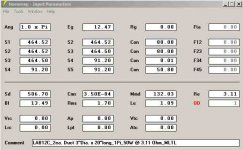 LAB12C_MLTL_2014_Jun01_Input.jpg27.3 KB · Views: 154
LAB12C_MLTL_2014_Jun01_Input.jpg27.3 KB · Views: 154 -
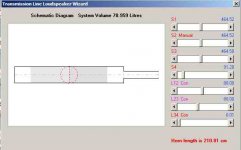 LAB12C_MLTL_2014_Jun01_Box.jpg15.1 KB · Views: 162
LAB12C_MLTL_2014_Jun01_Box.jpg15.1 KB · Views: 162 -
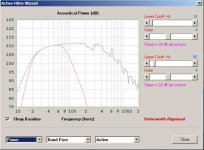 LAB12C_MLTL_2014_Jun01_SPL_Filters.jpg20.9 KB · Views: 161
LAB12C_MLTL_2014_Jun01_SPL_Filters.jpg20.9 KB · Views: 161 -
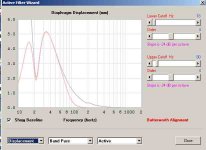 LAB12C_MLTL_2014_Jun01_Filtered Displacement.jpg19.8 KB · Views: 77
LAB12C_MLTL_2014_Jun01_Filtered Displacement.jpg19.8 KB · Views: 77 -
LAB12C_1.txt982 bytes · Views: 52
Last edited:
Hi,
Sealed two LAB12's (6 ohm version) in well stuffed 3.3 cuft would be fine.
The LAB12C needs to be used vented, with its lower Qts than the LAB12.
rgds, sreten.
Sealed two LAB12's (6 ohm version) in well stuffed 3.3 cuft would be fine.
The LAB12C needs to be used vented, with its lower Qts than the LAB12.
rgds, sreten.
Last edited:
- Status
- Not open for further replies.
- Home
- Loudspeakers
- Subwoofers
- Please help a newbie to design/build a pair of corner subs.
